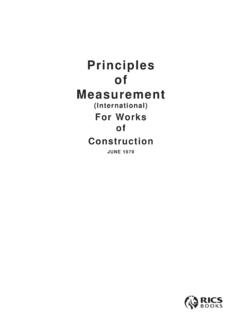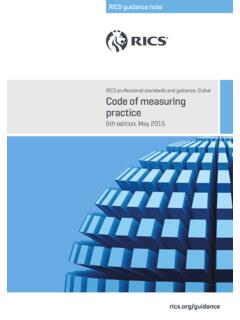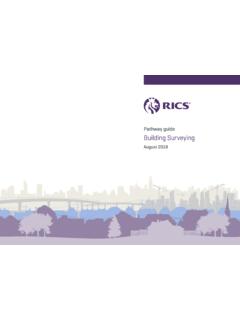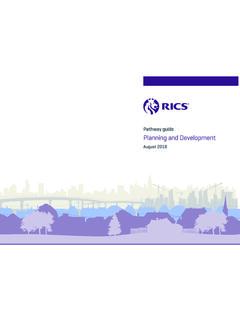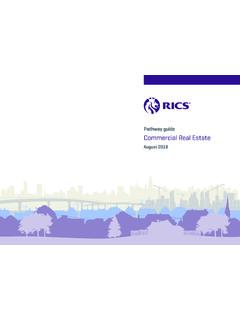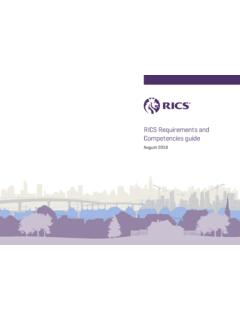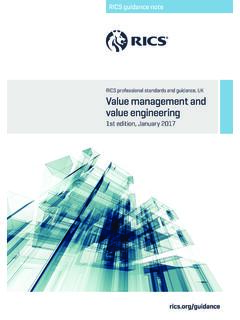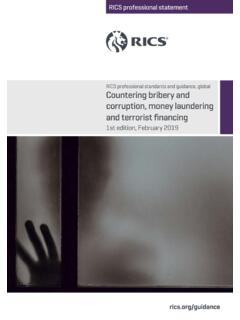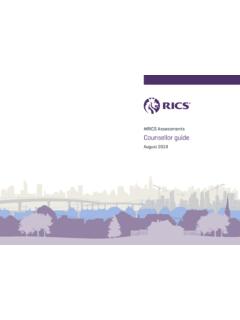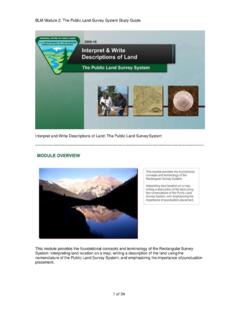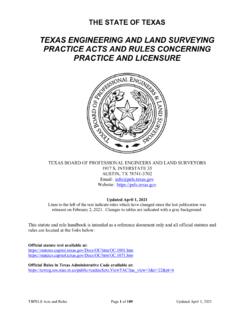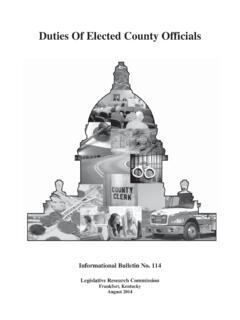Transcription of RICS Building surveys and technical due diligence of ...
1 Building surveys and technical duediligence of commercial propertyRICS Practice Standards, UK4th edition, guidance noteBuilding surveys and technical duediligence of commercial property4th edition, guidance noteThe fourth edition of this guidance note aims to provide surveyors withinformation and guidance in respect of commercial property surveys . It covers: taking instructions; survey preparation; inspection; and included are appendices comprising: a summary of insurance issues; a summary of legal issues; and useful sources of information and further reading. GN 63 surveys and technical due diligenceof commercial propertyRICS guidance note4th edition (GN 63/2010)Published by the Royal Institution of Chartered Surveyors (RICS) surveyor CourtWestwood Business ParkCoventry CV4 responsibility for loss or damage caused to any person acting or refraining from action as a result of the material included in this publication canbe accepted by the authors or by the Building Surveying Professional Group of the Royal Institution of Chartered edition published 1983 (previous titleGuidance note on structural surveys of commercial and industrial property)Second edition published 1998 (previous titleBuilding surveys and inspections of commercial and industrial property)Third edition published 2005 (previous title same as second edition)
2 ISBN 978 1 84219 627 4 Royal Institution of Chartered Surveyors (RICS) November 2010. Copyright in all or part of this publication rests with RICS, and save by priorconsent of RICS, no part or parts shall be reproduced by any means electronic, mechanical, photocopying or otherwise, now known or to in Great Britain by Columns Design Ltd, Reading, BerksPrinted in Great Britain by Annodata Print Services, Dunstable, BedsContentsRICS guidance notes1 Acknowledgments21 Introduction32 Taking Key Vendor Client The Confirming the Third party consultants and their Scope of services and RICS appointment Working in Europe93 Preparing for the General Health and safety for the surveyor124 The General Inspection, note taking and reflective Main Building Building External areas.
3 Outbuildings and Health and safety Fire Environmental Deleterious and hazardous Sustainability Cultural Matters for the legal adviser s attention205 The General Report Report contents23 Appendices26A Insurance26A1 Compulsory professional indemnity insurance regulations26A2 Merrett v Babb26A3 Professional indemnity insurance26A4 Private work26 Building surveys AND technical DUE diligence OF COMMERCIAL PROPERTY| iiiA5 Subrogation26A6 Third party rights26A7 Third party liability insurance27A8 Working outside of the UK and Ireland27A9 New legislation and disciplines27B Legislation and legal issues28B1 Duty of care28B2 Negligence28B3 Contract and limitation28B4 Legislation29B5 Civil Procedure Rules29C Useful information sources30C1 Links30C2 Further reading30iv | Building surveys AND technical DUE diligence OF COMMERCIAL PROPERTYRICS guidance notesThis is a guidance note.
4 It provides advice toRICS members on aspects of their procedures are recommended forspecific professional tasks, these are intendedto embody best practice , procedures whichin the opinion of RICS meet a high standard ofprofessional are not required to follow the advice andrecommendations contained in the note. Theyshould, however, note the following an allegation of professional negligence ismade against a surveyor , the court is likely to takeaccount of the contents of any relevant guidancenotes published by RICS in deciding whether or notthe surveyor had acted with the opinion of RICS, a member conforming tothe practices recommended in this note shouldhave at least a partial defence to an allegation ofnegligence by virtue of having followed thosepractices. However, members have theresponsibility of deciding when it is appropriate tofollow the the other hand, it does not follow that memberswill be adjudged negligent if they have not followedthe practices recommended in this note.
5 It is foreach surveyor to decide on the appropriateprocedure to follow in any professional , where members depart from the practicerecommended in this note, they should do so onlyfor a good reason. In the event of litigation, thecourt may require them to explain why theydecided not to adopt the recommended , if you have not followed this guidance, andyour actions are called into question in an RICS disciplinary case, you will be asked to justify thesteps you did take and this may be taken addition, guidance notes are relevant toprofessional competence in that each surveyorshould be up-to-date and should have informedhim or herself of guidance notes within areasonable time of their surveys AND technical DUE diligence OF COMMERCIAL PROPERTY|1 AcknowledgmentsThis guidance note was produced by the RICS Building Surveying Professional Group under the direction ofa working group.
6 RICS would like to express its thanks to the following who contributed to its groupIan Bragg, BSc MRICS, GVA Grimley LtdLaura Brazil, RICSAlex Charlesworth, BSc (Hons) MRICS, Cushman & Wakefield LLPN evin Hutchinson, BSc (Hons) MRICS, King Sturge LLPD avid Mann (Chair), BSc (Hons) MRICS, Tuffin Ferraby Taylor LLPT revor Rushton, FRICS ACIArb FBEng, Watts Group plcThe working group expresses its thanks in particular to the following contributors:Pat Coleman, Faber Maunsell | AECOMM ichael Earp, FINEX Global, Willis LimitedJason Juden, SJ Berwin LLPGlyn Thomas, Land Securities Properties Ltd2| Building surveys AND technical DUE diligence OF COMMERCIAL PROPERTY1 IntroductionThis guidance note has been prepared to providesurveyors and clients with a source of informationand guidance in respect of commercial andindustrial property surveys .
7 Such surveys may alsoinclude large residential apartment guidance is written to apply to England andWales, although much of its content is equallyapplicable elsewhere. It is operative from October2010 from which time the RICS publicationBuildingsurveys and inspections of commercial andindustrial property, 3rd edition, ceases to be guidance of this nature cannot cover allcircumstances and each property should beassessed on an individual basis having regard tothe specific needs of the client. The guidanceoffered is considered adaptable for all types ofcommercial and industrial property. It is acceptedthat surveyors may well have good reasons for notfollowing all aspects of this guidance note. It is forthe surveyor to decide upon such issues dependingon the individual circumstances, nature ofconstruction or site is not intended to be an instruction manual ora guide detailing a step-by-step process whichmust be followed.
8 It aims to set out the generalprinciples which should be adopted whenundertaking a Building is concerned that members only holdthemselves out to be competent in fields for whichtheir training and background experience areappropriate and relevant. It is important thatsurveyors undertaking commercial and industrialbuilding surveys have relevant experience in thisfield, have appropriate knowledge of buildingconstruction and are sufficiently skilled to inspectand report on the particular property providing commercial and industrialbuilding surveys and associated services areadvised to:+assess the needs of the client;+consider the extent of the investigations to bemade, advise on the limitations of the agreedinspection and obtain instructions from theclient for any additional services required (thelife cycle flow chart on page 6 refers to typicalbuilding survey types).
9 +undertake an impartial and professionalassessment of the property and its condition,and report to the client in the detail and stylenecessary to provide a balanced professionalopinion to the extent required by the agreedinstructions; and+comply with the agreed instructions, whichshould have been confirmed in writing, andform the basis of the contract between theclient and the benefits to the client of commissioning abuilding survey, whether a prospective purchaser,occupier or investor in property includes:+gaining an understanding of the condition anddesign of the property;+establishing the suitability of the property for itsintended use;+understanding the need for, and quantifying,future costs and other liabilities;+providing a level of protection for institutionalinvestors or funders; and+providing a basis for negotiation with thevendor or guidance note has been prepared by a groupof experienced surveyors connected with thecommercial property industry.
10 A full list of thosecontributing to the guidance is shown in theacknowledgments surveys AND technical DUE diligence OF COMMERCIAL PROPERTY|32 Taking itemsIt is important to remember that the client may notbe familiar with the range of services that thesurveyor is able to offer. When a client asks for asurvey, it is recommended that the surveyor asksquestions to ensure that the type of survey beingrequested is the right one for the example, if a client asks for a schedule ofcondition, the client may mean a buildinginspection report. The surveyor should assess theneeds of the client and advise on all of the servicesthat can be are key items common to confirminginstructions no matter what the commission orscope of work. These are recommended as basicgood administration and may include confirming:+precisely who the client/other parties are, and occupiers;+precisely what service is to be provided;+precisely who the surveyor /surveying companyis;+what is not being provided ( a valuation);+the detailed limitations on the scope of thesurvey and report;+the date of the instruction;+involvement of other consultants or contractorsand the extent of their appointment ( onbehalf of the client);+the timescales for completing the instructionand any intermediate stages;+what the fee will be;+how variations to the instruction will beassessed;+specialist access required, access restrictionsand health and safety;+how the fee will be claimed/become payableand the charges for late payment.
